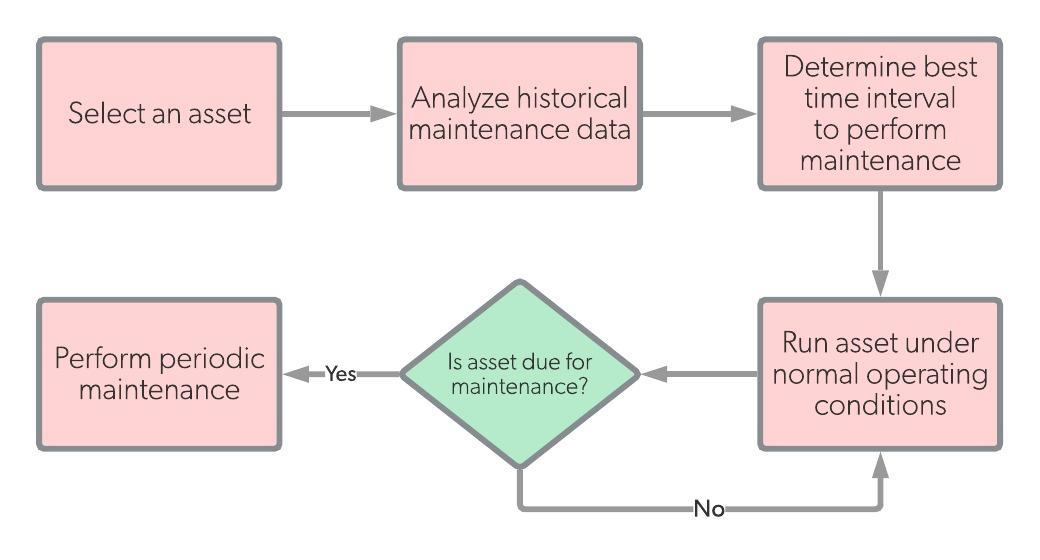Periodic maintenance refers to activities performed on equipment based on a set time interval. The purpose of periodic maintenance, or time based maintenance, is to maintain smooth operation of a machine or other asset.
Periodic maintenance workflow
 Overview
Overview
Wear and tear in equipment is unavoidable and assets would usually have a finite life span before eventually being retired from operations. The good news is, equipment doesn’t just go end-of-life overnight. On the contrary, production assets are designed to be durable enough to last long periods. Within an equipment’s life cycle, there is ample time to periodically check its condition to maximize its use.
Periodic maintenance, also known as time-based maintenance, is a strategy that requires maintenance tasks to be performed at set time intervals while the asset is operational. Similar to scheduled maintenance, periodic maintenance activities are planned ahead of time and are performed regardless of whether signs of deterioration are prevalent or not.
The identification of the interval and frequency of service tasks are evaluated depending on parameters specific to the asset. An equipment manufacturer might suggest calendar-based schedules to perform checks on your asset. For instance, an aircon manufacturer might recommend your window-type air conditioning unit to be cleaned out once a year as a general guideline.
How periodic maintenance works
The effectiveness of periodic maintenance is based upon the assumption that the failure of assets can be predicted by time. Identifying the period that an asset is likely to operate without issues will lead you to ideal checkpoints to perform periodic maintenance. The idea is to service the equipment before an actual failure occurs.
Historical data, obtained by metrics or through experimental results, provides the foundation for identifying the period before which equipment would need to be worked on. Given equipment with a robust mean time between failure (MTBF) data will allow you to determine the best time to perform checks and service tasks.
Having software that can enable a more accurate and consistent collection of data, such as a CMMS program, will equip you with more reliable information. Failure analysis based on dependable data enables maintenance planners to make more informed decisions.
5 Examples
The industrial applications of time-based maintenance usually solve replacement and repair-replacement problems. Examples include:
- Changing out lubricating oils
- Checking bearing grease
- Replacing filter elements
- Cleaning up corrosion
- Checking pressure/temperature gauges
For equipment that is used over consistent running periods, the rate of deterioration can be accurately approximated as calendar periods. A bus that goes over the same route daily, for example, can be expected to require fuel refills at predictable intervals.
Periodic maintenance will be less effective on equipment that is used more variably. If the equipment is prone to random breakdowns, or if the equipment has inconsistent MTBF values, consider using a maintenance approach that is not time-based.
Pros and cons of periodic maintenance
The benefit of performing time-based maintenance activities is that it doesn’t require additional equipment to decide on when equipment needs to be serviced. Initial costs to come up with time-based schedules are very minimal. A periodic maintenance program would rely more on historical data and analysis rather than additional physical devices that can incur more costs.
The downside to performing purely time-based maintenance is that there is a risk of performing unnecessary activities. It is estimated that up to 30% of time-based preventive tasks are done too frequently.
Another challenge of solely performing the maintenance is that failure due to random events can occur. There are certain breakdowns that are not dependent on time and can therefore occur before the scheduled maintenance check.
Conclusion
Periodic or time-based maintenance assumes that equipment failure can be predicted over time. It is a maintenance strategy that is applicable to equipment that has a foreseeable life span based on historical data or manufacturer specifications. Assets that are more prone to random failures are less likely to benefit from periodic maintenance.

![[Review Badge] Gartner Peer Insights (Dark)](https://www.datocms-assets.com/38028/1673900494-gartner-logo-dark.png?auto=compress&fm=webp&w=336)
